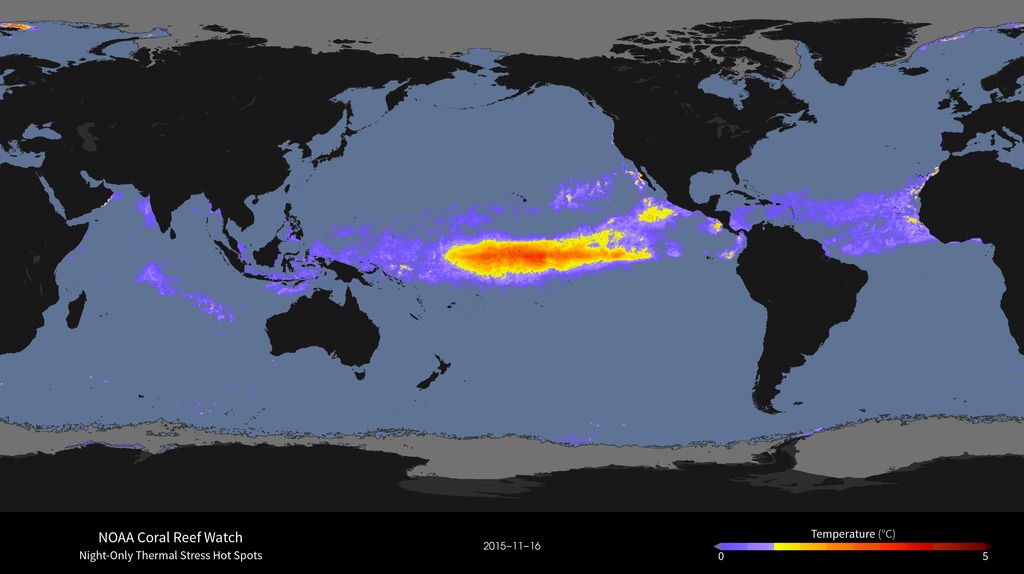A newer version of this visualization is available.
Monitoring Coral Reefs
NOAA Coral Reef Watch’s thermal stress monitoring product suite
NOAA Coral Reef Watch’s (CRW) next generation high resolution bleaching thermal stress monitoring product suite comprises 5 products. Beginning with Sea Surface Temperature from NOAA NESDIS, several processing steps lead to the final Bleaching Alert Areas product.
Global data from Gang Liu at NOAA (via Liane Guild at AMES) for Oceans 2014
CRW Coral Bleaching Alert Area product outlines the areas where bleaching thermal stress currently reaches various bleaching stress levels, based on satellite sea surface temperature monitoring. There are five stress levels in the product ranging from 1: "No Stress" up through 5: “Mortality Likely”. The timing of the peak bleaching season varies among ocean basin and hemispheres but it is generally during the summertime.
Mass coral bleaching has been shown to be caused by prolonged periods of thermal stress, and NOAA CRW’s Degree Heating Weeks (DHW) product is developed to measure the accumulation of the intensity and duration of thermal stress. It accumulates any HotSpots greater than 1 degree C over a 12-week window, thus showing how stressful conditions have been for corals in the last three months. This is in contrast to HotSpot product, which provides an instantaneous measure of the thermal stress.
Corals are vulnerable to bleaching when the SST exceeds the temperatures normally experienced in the hottest month. This is shown in CRW’s Coral Bleaching HotSpot product, which measures the occurrence and magnitude of the thermal stress which may cause coral bleaching. Its value shows the difference between the measured global SST and the climatological mean SST for the hottest month. Only positive values are derived, since the HotSpot is designed to show the occurrence and distribution of thermal stress conductive to coral bleaching.
NOAA CRW’s 5km SST anomaly experimental product is produced by subtracting the long term mean SST from the current value. A positive anomaly means that the current sea surface temperature is warmer than average, and a negative anomaly means that it is cooler than average. CRW’s near-real-time global SST anomaly product makes it possible to quickly pinpoint regions of elevated SSTs throughout the world oceans. It is especially valuable for the tropical regions because this is where most of the world’s coral reef ecosystems thrive.
The daily global 5km (0.05 degree exactly) resolution GOES-POES day night blended SST data set is a new SST product recently developed by NOAA NESDIS’s SST Team. This data set serves as the source data for NOAA Coral Reef Watch’s (CRW) next generation high resolution bleaching thermal stress monitoring product suite, in the hope of replacing the current operational twice-weekly 50km (0.5 degree exactly) product suite. With higher spatial and temporal resolution products, CRW can now provide information at or close to reef-scales.
For More Information
Credits
Please give credit for this item to:
-
Project support
- Eric Sokolowsky (Global Science and Technology, Inc.)
-
Technical support
- Marit Jentoft-Nilsen (Global Science and Technology, Inc.)
Related papers
Liu, G.; Heron, S.F.; Eakin, C.M.; Muller-Karger, F.E.; Vega-Rodriguez, M.; Guild, L.S.; De La Cour, J.L.; Geiger, E.F.; Skirving, W.J.; Burgess, T.F.R.; Strong, A.E.; Harris, A.; Maturi, E.; Ignatov, A.; Sapper, J.; Li, J.; Lynds, S. Reef-Scale Thermal Stress Monitoring of Coral Ecosystems: New 5-km Global Products from NOAA Coral Reef Watch. Remote Sens. 2014, 6, 11579-11606.
Liu, G.; Heron, S.F.; Eakin, C.M.; Muller-Karger, F.E.; Vega-Rodriguez, M.; Guild, L.S.; De La Cour, J.L.; Geiger, E.F.; Skirving, W.J.; Burgess, T.F.R.; Strong, A.E.; Harris, A.; Maturi, E.; Ignatov, A.; Sapper, J.; Li, J.; Lynds, S. Reef-Scale Thermal Stress Monitoring of Coral Ecosystems: New 5-km Global Products from NOAA Coral Reef Watch. Remote Sens. 2014, 6, 11579-11606.
Release date
This page was originally published on Saturday, February 22, 2014.
This page was last updated on Sunday, February 2, 2025 at 11:32 PM EST.
